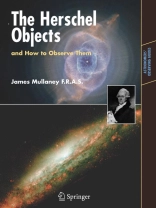Amateur astronomers – particularly deep-sky observers – are always on the lookout for new observing challenges. The Herschel Objects, and How to Observe Them offers the exciting opportunity of retracing the steps of the greatest visual observer and celestial explorer that ever lived. This is a practical guide to seeing the most impressive of Herschel’s star clusters, nebulae and galaxies.
There has never been – and as of the time of submitting this proposal there still isn’t – an observer’s book devoted to the Herschel objects. The US-based Astronomical League has for several years sponsored a ‘Herschel Club’, reflecting the interest amateur astronomers have in this important but less widely known listing. The Herschel Objects, and How to Observe Them covers more than 600 of the brightest of the objects that Herschel saw, with detailed descriptions and images of 150 to 200 of the very best for viewing with amateur telescopes.
สารบัญ
William Herschel’s Life, Telescopes and Catalogs.- Herschel’s Telescopes.- Herschel’s Catalogs and Classes.- Observing Techniques.- Exploring The Herschel Showpieces.- Showpieces of Class I.- Showpieces of Class IV.- Showpieces of Class V.- Showpieces of Class VI.- Showpieces of Class VII.- Showpieces of Class VIII.- Samples of Classes II & III.- Showpieces Missed by Herschel.- The “Missing” Herschel Objects.- Conclusion.
เกี่ยวกับผู้แต่ง
James Mullaney is an astronomy writer, lecturer and consultant who has published more than 500 articles and five books on observing the wonders of the heavens, and logged over 20, 000 hours of stargazing time with the unaided eye, binoculars and telescopes. Formerly Curator of the Buhl Planetarium and Institute of Popular Science in Pittsburgh and more recently Director of the Du Pont Planetarium, he served as staff astronomer at the University of Pittsburgh’s Allegheny Observatory and for Spitz Space Systems. He has also been an editor for Sky & Telescope, Astronomy, and Star & Sky magazines. One of the contributors to Carl Sagan’s award-winning Cosmos PBS-Television series, his work has received recognition from such notables as Sir Arthur Clarke, Johnny Carson, Ray Bradbury, Dr. Wernher von Braun, and former student – NASA scientist/astronaut Dr. Jay Apt. In February of 2005, he was elected a Fellow of the prestigious Royal Astronomical Society of London.












